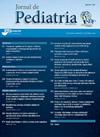Evaluation of the level of information of pediatricians about the diagnosis and management of cryptorchidism
IF 2.8
4区 医学
Q1 PEDIATRICS
引用次数: 0
Abstract
Objective
Evaluate the level of information of pediatricians about the diagnosis and management of cryptorchidism.
Method
A cross-sectional observational study was conducted using a form via the "Google Forms" platform. The study population included pediatricians and pediatric residents associated with the Brazilian Society of Pediatrics. Seven hundred twenty-eight responses were recorded and analyzed using IBM SPSS v21.
Results
728 valid responses were obtained. Of these answers, only 20.5 % answered that the physical examination was sufficient for the diagnosis, and 79.4 % responded that they requested ultrasound as the best test to aid in diagnosing cryptorchidism. When questioned about the ideal age for referring a patient with cryptorchidism, the survey recorded 56.3 % of the responses defending the correct age as six months old, 30.2 % shortly after birth, and 13.2 % at two years old. Other topics were addressed in the form, such as the frequency of evaluation of testicular position and investigation for DDS, among others. Still, the answers to these questions were compatible with current manuals and guidelines on cryptorchidism.
Conclusion
It is evident that the understanding of the professionals consulted about the diagnosis and management of cryptorchidism needs to be updated with the current practices adopted and that pediatricians, in general, must maintain periodic programs on this subject. Therefore, this topic should be part of a continuing education program with pediatric surgery.
评估儿科医生对隐睾症诊断和治疗的了解程度。
目的:评估儿科医生对隐睾症诊断和治疗的了解程度:评估儿科医生对隐睾症诊断和治疗的了解程度:采用 "谷歌表格 "平台上的表格进行横断面观察研究。研究对象包括与巴西儿科学会有联系的儿科医生和儿科住院医师。记录了 728 份回复,并使用 IBM SPSS v21 进行了分析:结果:共获得 728 条有效回复。在这些回答中,只有 20.5% 的人认为体格检查足以做出诊断,79.4% 的人认为超声波是帮助诊断隐睾症的最佳检查方法。当被问及隐睾症患者的理想转诊年龄时,调查记录显示 56.3% 的回答将正确年龄定义为六个月大,30.2% 的回答将正确年龄定义为出生后不久,13.2% 的回答将正确年龄定义为两岁。调查表中还涉及了其他一些问题,如评估睾丸位置的频率和 DDS 调查等。尽管如此,这些问题的答案与目前有关隐睾症的手册和指南是一致的:很明显,接受咨询的专业人员对隐睾症的诊断和处理的理解需要根据当前采用的方法进行更新,而且儿科医生必须定期开展有关这一主题的课程。因此,该主题应成为小儿外科继续教育课程的一部分。
本文章由计算机程序翻译,如有差异,请以英文原文为准。
求助全文
约1分钟内获得全文
求助全文
来源期刊

Jornal de pediatria
医学-小儿科
CiteScore
5.60
自引率
3.00%
发文量
93
审稿时长
43 days
期刊介绍:
Jornal de Pediatria is a bimonthly publication of the Brazilian Society of Pediatrics (Sociedade Brasileira de Pediatria, SBP). It has been published without interruption since 1934. Jornal de Pediatria publishes original articles and review articles covering various areas in the field of pediatrics. By publishing relevant scientific contributions, Jornal de Pediatria aims at improving the standards of pediatrics and of the healthcare provided for children and adolescents in general, as well to foster debate about health.
 求助内容:
求助内容: 应助结果提醒方式:
应助结果提醒方式:


